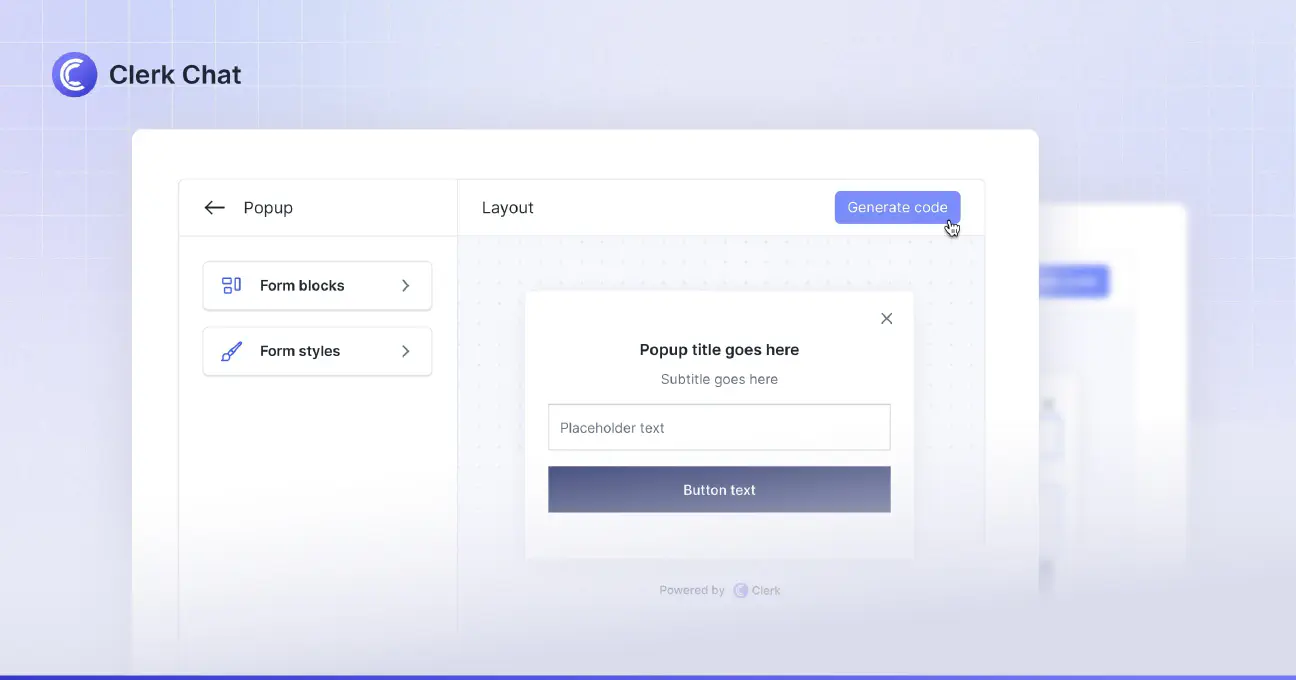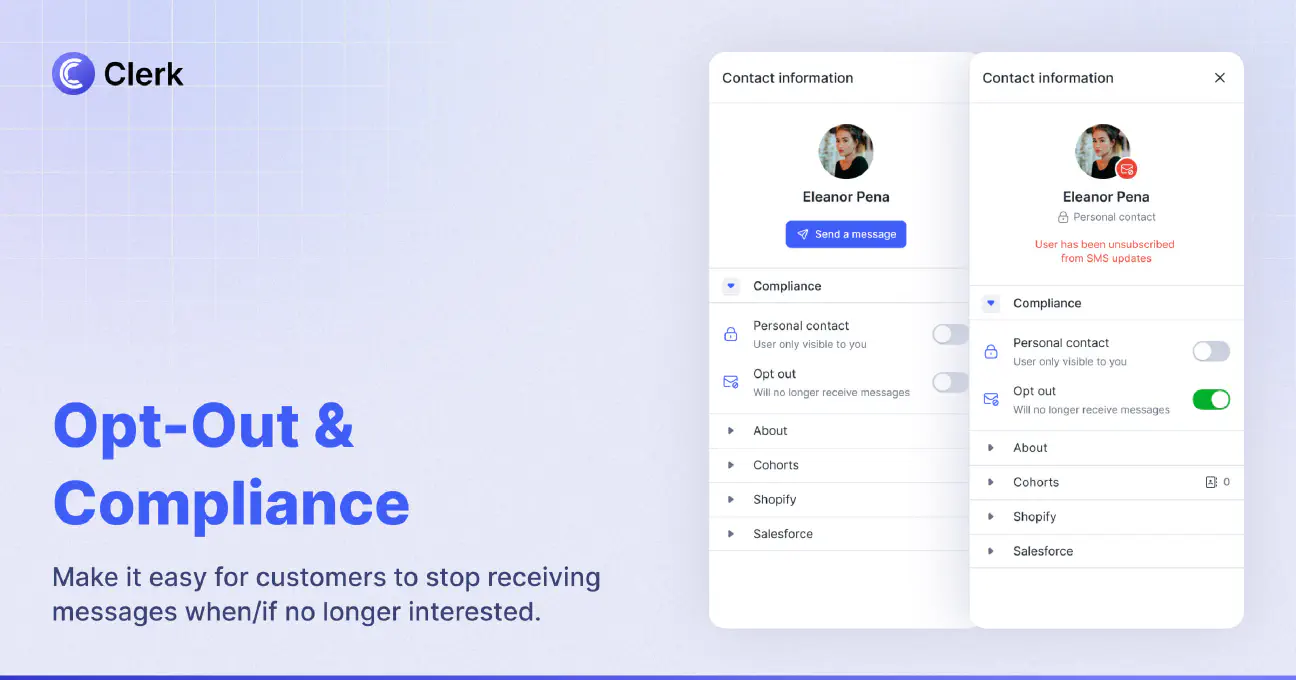Mastering SMS Opt-In and SMS Opt-Out: The Complete Guide
By Team Clerk Chat
- Updated: August 23, 2024
Free 10DLC Whitepaper
SMS opt-in and SMS opt-out messages are more important to your company’s marketing and communications strategies than you might think. The way you approach these messages will influence how effectively you adhere to SMS compliance guidelines, and avoid legal repercussions.
Plus, the right strategies can influence how well you collect and convert leads for your company, as well as having an impact on your brand’s overall reputation.
Unfortunately, while many companies are familiar with the concept of opt-in and opt-out messages, most still don’t know how to use them to their advantage.
Here, we’ll guide you through everything you need to know about SMS opt-in and opt-out messages to help boost your chances of successful SMS marketing campaigns.
What is an Opt-in Text Message?
An opt-in text message is a message you receive from your customer, giving you explicit consent to communicate with them through promotional SMS messages. In many countries, including the United States, various regulatory guidelines, such as TCPA rules, and specific industry mandates require all companies to obtain “written consent” from customers, before they contact them on any channel.
Notably, while you don’t necessarily need customers to opt-in to transactional text messages, such as the messages you send to confirm that you’ve received an order, or let customers know their package is on its way, you do need consent for all promotional messages.
Double Opt-In Meaning in Text Message Marketing
Most companies today ensure they can maintain compliant business communication standards, using the “double opt-in” method. This basically means when a customer enters their phone number into your online form or landing page, giving you permission to communicate with them, you send them a second opt-in text message confirming their permission.
For instance, you might simply ask a customer to reply “YES” to a message if they want to continue receiving marketing messages from you. This strategy can further reduce your risk of fines and regulatory issues, because it gives you two documented instances of a customer giving you permission to contact them. Plus, it can help ensure you’re only spending money communicating with SMS leads who genuinely want to hear from your brand.
At the same time, the double opt-in method gives you a way to “break the ice” with a customer, and start a conversation with them via SMS.
SMS Opt-In Message Examples
Usually, an SMS opt-in strategy starts with a company requesting contact details from a customer. There are a few different ways you can do this. For instance, you could send an email to a customer asking them to “opt-in” to your automated messaging service for a chance to hear about new promotions and products faster than anyone else.
You could also create a landing page on your website where customers can enter their contact details, and then respond to an opt-in text message from you to confirm they want to receive your content. Alternatively, you could just add an “opt-in” form to a customer’s account page, or use a pop-up on your website to invite them to opt-in to SMS marketing.

Clerk Chat provides a free form builder tool that is customizable and easy to add to your website. While this tool can be used for various sign-ups, contact collection, or even coupon codes, it’s often frequently used and extremely helpful for SMS opt-in.
If you choose the “double opt-in” method, rather than just immediately sending customers marketing materials as soon as they share their contact details, you’ll send them a message asking them to confirm they want to hear from you first.
This could just mean sending an automated message to your customer as soon as they submit their details, asking them to respond with a “YES”, a “Y”, or a “NO”.
Once your customer responds letting you know they want to hear from you, you’ll usually send them a “welcome” message. This message lets them know what they can expect from the service, and how they can “opt-out” if they decide they don’t want to communicate with you anymore.
Why is SMS Opt-In Important for Businesses?
So, why do you need to bother with an SMS opt-in process? First, as we mentioned above, getting explicit consent to send marketing materials to customers over text is crucial to stay compliant with industry standards. Getting an “opt-in” message from your customers means you can adhere to your TCPA checklist and avoid fines from industry regulators.
In certain industries, this opt-in message is particularly important. For instance, if you’re using SMS for finance marketing, FINRA requires you to collect explicit permission from customers. If you don’t, you risk some serious fines.
On top of that, a strong SMS opt-in strategy has a few other benefits. It can:
- Help you collect more leads: Rather than just relying on email to nurture leads, you’ll also be able to use SMS to capture more potential customers for your business. Around 64% of customers prefer using SMS to email, so you could reach a wider audience.
- Increase engagement: With SMS, you have a fantastic way to communicate with customers wherever they are, throughout their purchasing lifecycle. You don’t have to wait until someone sees your social media posts, blog posts, or emails to promote new products.
- Boost sales and revenue: At the beginning of your SMS opt-in strategy, you can deliver a discount or incentive to customers, inspiring them to make a purchase. After they buy something, you can continue to interact with them, using personalized campaigns to guide them towards the right products and increase conversions.
Plus, an opt-in text message strategy for your SMS marketing strategy can reduce your marketing costs. Instead of spending thousands of dollars trying to connect with as many customers as possible, you can focus your attention and budget on the people you know want to hear from you.


What is an Opt-Out Text Message?
An opt-out text message is a message a customer sends a company to let them know they don’t want to receive their promotional messages anymore. Customers have the right to decide when and if they want to hear from companies across various channels.
Allowing your customers to “opt out” of receiving your conversational SMS marketing messages and campaigns is something all companies need to do by law.
If you want to adhere to 10DLC compliance standards, and other regulatory mandates, you need to make it easy for customers to stop hearing from you.
As soon as a customer sends you an SMS opt-out message, you will need to update your CRM or contact database and remove them from your messaging strategy completely. This means taking them off the lists you use for mass text messaging, and other promotional strategies.
Notably, you may still be able to send transactional messages to customers after they send you an “opt-out” text message. But none of the messages you send can be defined as “soliciting” messages – which means they can’t encourage customers to buy anything.
Opt-Out Text Message Examples
To ensure you’re complying with industry communications standards, you should ensure all of your customers know how to “opt out” of your messages at any time. You don’t necessarily need to include instructions on how to opt-out in every text you send.
However, it’s usually good practice to include those instructions in the last message you send in a conversation. For instance, if you send a few different messages highlighting new products, you might include a short note telling customers they can text “STOP” to put your messages on hold.
Most opt-out text messages should be pretty simple, allowing customers to stop your messages with a single word. Don’t make your customers fill out complicated forms or provide feedback before you remove them from your list, as this could put you in danger of fines.
Additionally, remember that while you need to stop communicating with customers immediately after they send you an opt-out text message, you can still use an automatic reply to confirm that they’ve opted out, and share additional details, like who to contact if they change their mind.

SMS Opt-in and SMS Opt-Out Message Compliance
As mentioned above, one of the main reasons an SMS opt-in and opt-out messaging strategy is so crucial is that it ensures you can adhere to a range of compliance standards. You need to use these messages after you apply for an A2P 10 digit long code, to remain compliant.
CAN-SPAM act text messages also require companies to get explicit consent when sending promotional messages and honor opt-out requests.
Plus there are various other regulations that expressly outline the need for opt-in and opt-out messages in SMS marketing. One important thing to remember, however, is that these guidelines only apply to promotional text messages. Promotional messages are any message you send to a customer prompting them to do something, whether it’s attending an event or purchasing a product.
Even if you’re using AI texting and messages don’t come directly from your team, you can’t send promotional texts without written, explicit consent.
On the other hand, you don’t need written consent to send transactional emails. Transactional emails are the messages that contain essential information your customer might need. For instance, they might confirm that a buyer has placed an order, enable two-factor authentication, or provide access to information about tracking an order.
The simple act of a customer giving you their contact details when they place an order is enough to count as “consent” to receive this kind of message. Just make sure you don’t accidentally include any promotional content in those messages.
The Key Compliance Rules to Keep in Mind
Notably, different carriers and government groups have specific rules businesses need to follow when it comes to texting. If you’re investing in application to person messaging, or any other form of SMS, research the guidelines in your industry and country before you start creating your campaigns. In the US, these are the main rules you need to be aware of:
- Collecting consent: Companies sending promotional SMS messages must obtain explicit, written consent from customers before sending any messages. This consent must be recorded, and customers must know what they’re consenting to.
- Opt-out options: Organizations must give recipients an easy way to “opt-out” of receiving text. They must provide clear instructions on how to opt out and honor unsubscribe requests promptly.
- Informing customers: Guidelines like the TCPA require companies to provide insights into the terms and conditions of their messaging service. This means letting customers know why you’ll be texting, whether they’ll be charged for texts, and how often they’ll receive texts.
Additionally, senders using 10-digit local phone numbers for SMS will have to register under A2DP 10DLC. Even if you’re using your number through another platform, for something like Microsoft Teams SMS texting, you still need to be registered.

Opt-In Text Message Marketing Best Practices
Now you’re familiar with the opt in and opt out meaning in text message marketing, you might be wondering how you can boost your opt-in rates and increase conversions. Here are some of our top tips to boost your chances of a successful strategy.
1. Set Expectations Early
First, make sure your customers know what to expect if they send you an SMS opt-in message. Most people will be more reluctant to share their contact details with companies if they don’t know how often they’re going to receive messages or what those messages will be about.
On your sign-up page or form, let customers know exactly how often you’re going to be getting in touch, and what you’ll be messaging them about. Try to draw attention to the benefits of subscribing to your SMS service. For instance, let customers know that they’ll be the first to hear about new promotions and products.
This should increase your sign-up rate, and it will also help you to adhere to industry guidelines, such as TCPA, which require companies to be clear about their messaging policies.
2. Incentivize the SMS Opt-In
You can’t necessarily convince everyone to opt-in to your text messaging service just by promising them a reward. However, you’re far more likely to get people to sign up if they think they’re going to be getting something in return for their contact details.
Just like people are more likely to share their email address if you have a great lead magnet, like a discount or an exclusive gift to offer, the same is true for SMS marketing. Promise your customers something simple, but valuable, like a 10% discount on their first order.
Remember to make sure you actually deliver that incentive too. Set up an auto text reply strategy that immediately delivers discount codes to subscribing customers when they confirm they send you an opt-in text message.


3. Give Your Customers Options
Giving your customers too many options can be confusing in the marketing world. However, it can also be a good way to increase your conversion rates if you do it correctly. For instance, rather than just telling customers what they’ll receive from you if they send you an SMS opt-in message, ask them to choose the messages they want to receive.
You can use a preference center to allow customers to decide whether they want to receive all of your marketing messages or just messages about promotions and sales. Alternatively, you can consider giving customers other ways to stay in contact with you.
Offer them the option to sign up for your email newsletter and short code texting service at the same time. This is a good way to ensure you have various ways to communicate with your audience.
4. Keep it Simple
Opting into your text messaging service, and even sending you an opt-out text message should be as simple as possible for the customer. If a client needs to enter a lot of different details into a form just to receive marketing messages from you, they probably won’t bother.
Additionally, if they need to jump through hoops to unsubscribe, this will damage their perception of your brand and put you at risk of compliance issues.
Allow people to opt-in and opt-out quickly with one word texts. Additionally, when you’re sending messages to your customers, make sure they’re short and simple too. Don’t overwhelm your customers with endless messages. Only send them the most valuable content you have.
5. Use an Opt-In Text Message Service
An opt-in text message service, built into an SMS marketing platform like Clerk Chat, can save you a lot of time and effort when you’re building your campaigns. It can give you access to useful templates you can use for double opt-in methods and future marketing strategies.
Plus, it gives you a central environment where you can keep track of all of your contacts and their details. The right opt-in text messaging service will even integrate with your archiving tools, so you can keep clear records of the permission you receive from customers to contact them.
This will make it much easier to stay compliant with industry standards. Some even allow you to search for SMS keywords in seconds.
Opt-In to a Stronger SMS Marketing Strategy
SMS Opt-in and SMS Opt-out messages are something every company needs to master if they’re going to be using text for their promotional campaigns. While you don’t necessarily need these messages for customer service messaging or transactional messages, they’re essential for keeping your marketing campaigns compliant with industry standards.
Clerk Chat makes it easy to create SMS opt-in templates, design marketing campaigns, track opt-in and opt-out requests, and avoid compliance issues.
Learn how you can make the most of your SMS marketing strategy with a tool like Clerk Chat today. Contact us for a demo of our leading conversational messaging platform.
In this article:
- What is an Opt-in Text Message?
- SMS Opt-In Message Examples
- Why is SMS Opt-In Important for Businesses?
- What is an Opt-Out Text Message?
- Opt-Out Text Message Examples
- SMS Opt-in and SMS Opt-Out Message Compliance
- The Key Compliance Rules to Keep in Mind
- Opt-In Text Message Marketing Best Practices
- Opt-In to a Stronger SMS Marketing Strategy
Ready to use your business number for text messaging?
Thousands of businesses are already experiencing the power of conversational messaging through SMS. Join us. Free trial and paid tiers available.
Get Started#Subscribe
Get product updates in your inbox
Tutorials, features, and Clerk Chat news delivered straight to you.




